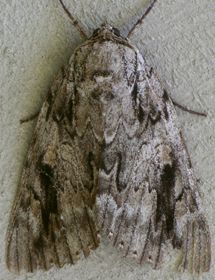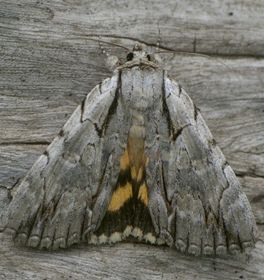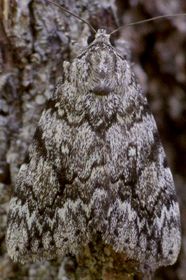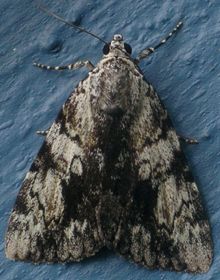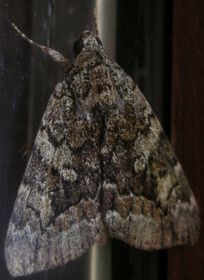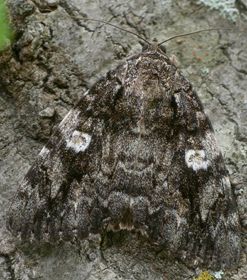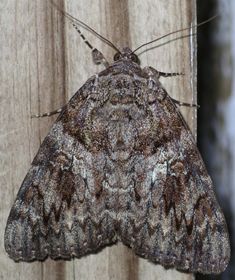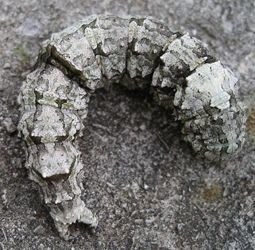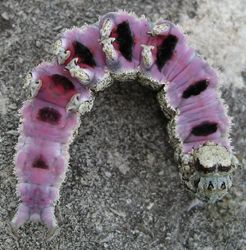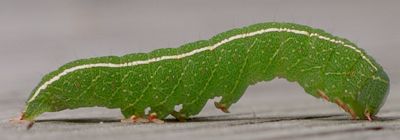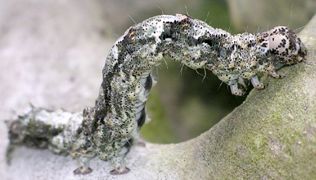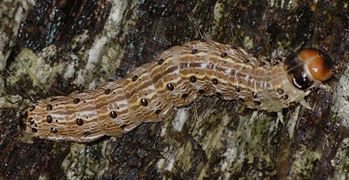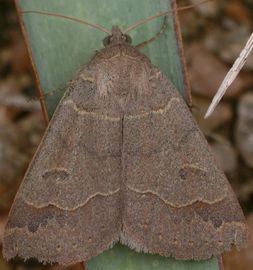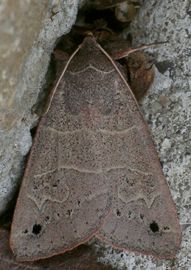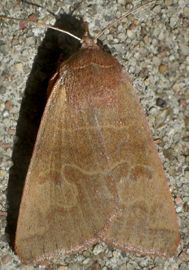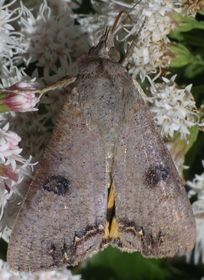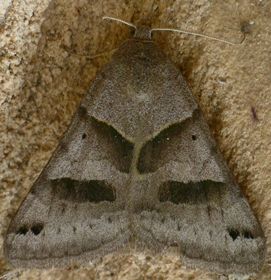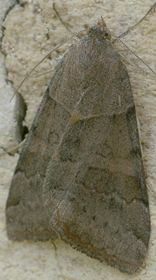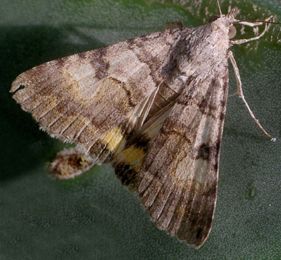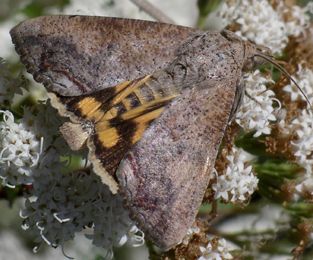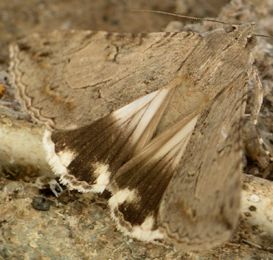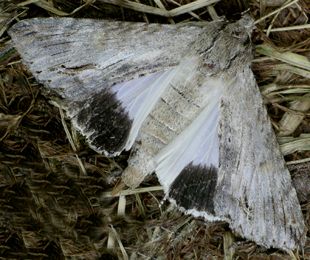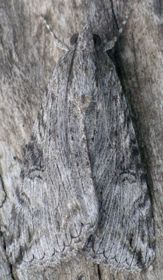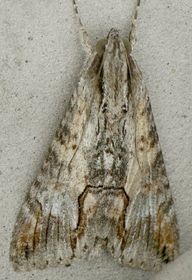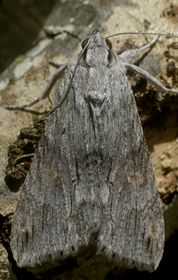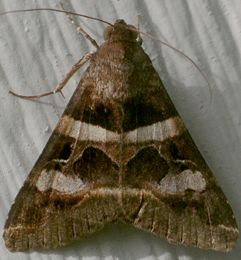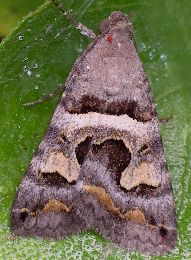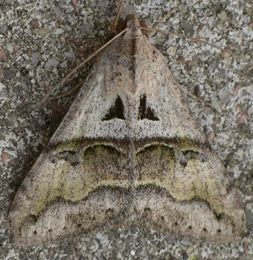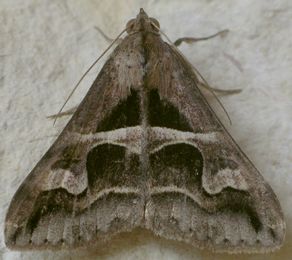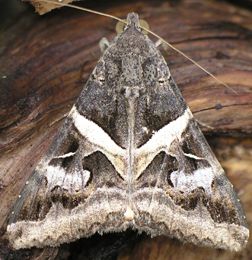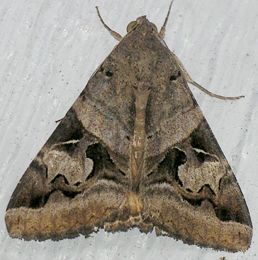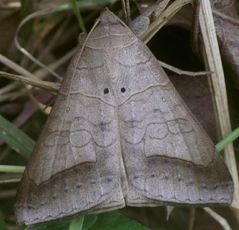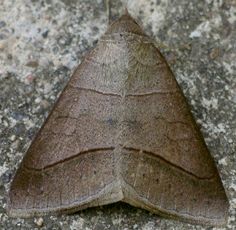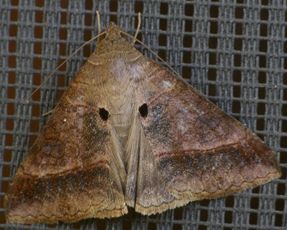
| Noctuidae ~ Owlet Moths |
page 1 ![]() page 2
page 2 ![]() page 3
page 3 ![]() page 4
page 4 ![]() page 5
page 5 ![]() page 6
page 6 ![]() page 7
page 7 ![]() page 8
page 8
|
Members of the genus Catocala are called underwings because many of them have orange and black lower wings that are kept hidden when at rest. They range from medium-sized to big. I don't find many of these moths, but sometimes they get scared up when I am hiking in wooded areas. They flash their orange colors as they fly and then land on a tree, blending in so well that I have a hard time finding them. Occasionally, especially if the temperature is cool or I haven't really scared them, underwings are reluctant to fly. Other times they are very skittish and impossible to approach.
The markings on these moths are quite complex and also a bit variable. They are really hard to ID with much confidence. If you can glimpse the lower wings, that helps narrow down the choices, as some have orange while others have mostly black. Size is also a good clue. The biggest such species I've seen is the Sad Underwing (Catocala maestosa), which is quite a behemoth. Okay, that's a bad pun. But the moth, at about 45 mm in length, does appear larger than most, being very massive looking, so that it looks like it would have a hard time getting airborne. It is the only Catocala that I've seen in October. The others I've found seem to be summer moths (May to Aug.). Both Catocala clintonii and C. micronympha have been single sightings for me, so I don't know much about them. The former was found in Waco, while the latter at Zilker Preserve here in Austin. I'm not completely confident in the C. micronympha ID, as it looks very similar to C. amica. By far the most common of the genus is the Girlfriend Underwing (Catocala amica). These are abundant in our backyard and I've found them in other places in south Austin. They are pretty small, only about 20 mm long. Sometimes there will be 5 or 6 fluttering around our back porch and a nearby oak, within 5 feet of the ground. The Ilia Underwing (Catocala ilia) is another large moth and is about 35 mm long. I find them occasionally in the same places as the previous species. They are not active, but their large size makes them noticeable. Even better than the adult Ilia Underwing is the caterpillar. The first time I saw one, it was brought to my attention by my dog, who was raptly watching something on the ground under one of our oak trees. When I investigated, I simply saw flashing purple. Upon closer examination, a 60 mm long caterpillar was flipping around, sometimes landing upside-down and sometimes right side up. It was very agitated. As you can see in the photos, the upper side is well camouflaged against lichen or rocks, while the purple belly produces an admirable "startle" factor. It certainly confused the dog!
While I'm on the subject of caterpillars, I'll include another interesting one. I've not yet found a Panopoda adult or larva around Austin, but we have three species reported for the area. The caterpillar pictured below was seen in Dallas. The distinctive look of larvae makes identification (at least to genus) rather easy.
A fair number of noctuid caterpillars move by "looping" in much the same way as inchworms, which are in the family geometridae. The difference is in the number of legs at the rear end. True inchworms only have two pairs while noctuids have three or more. Using a beat sheet (holding a stretched canvas under a branch to catch what falls when the plant is hit with a stick), vastly increases the number of larvae and other cryptic critters one can find. I rarely carry such equipment with me, so nearly all the caterpillars I find are by sight. This means that I am encountering only a tiny percentage of what is out there. Therefore, do not take my accounts here as a good example of what is common or not. The sampling is just not that representative. That disclaimer given, I do find various caterpillars, some more often than others. It helps to know host plants.
One very unusual caterpillar that I saw just once is the Palmetto Borer (Litoporsopus futilis). It has incredibly long setae (hairs) and this was a large specimen. It was crawling on the bark of an oak, but it was near some palms in Zilker Gardens so that is probably where it had been feeding. The Live Oak Metria (Metria amella) caterpillar is another looper. Living up to its name, I have found several under our Live Oak trees. They can be rather large larvae, growing to about 50 mm in length. Color is very mottled for camouflage and they have black spots in a line down their bellies. You can guess how the Forage Looper (Caenurgina erechtea) moves about. It is a rather common moth, especially in fields. The caterpillars are so well camouflaged that I rarely see them. I think they look rather like a stretched out baby in pajamas.
There are two species of Cissusa that, taking into account variability, look the same. Well, actually there are two forms that look really different, but I've seen both "types" classified as both species in various sources. Very confusing. One is C. spadix, the Black-dotted Brown and the other is C. mucronata. One authority on Texas moths states that the latter is our species. However, I cannot find verification of this, and so am not at all certain that is what we have, or the only species around. It could very well be the Black-dotted Brown also occurs here and that accounts for the variability (in color and presence/absence of black dots) I see. However, for the sake of simplicity, I'm tentatively assuming that our varied Cissusa individuals are all C. mucronata. I may revise this in the future when I learn more. Aside from the Cissusa problem, I find certain species difficult to tell apart, especially at a glance. The Common Oak Moth (Phoberia atomaris) and Cissusa mucronata are one such pair of look-alikes. They both occur in the early spring and well, they just look very similar. When viewed side by side, their differences are discernible, but they don't glaringly stand out. The more narrow wing position is characteristic for C. mucronata. The Common Oak Moth, despite its name, is actually the less frequently seen of these two.
To make matters worse, the light form of the Forage Looper Moth (Caenurgina erechtea) also looks much the same. All three of these moths are about 20 mm long. The Forage Looper Moth is quite variable and is sometimes very darkly marked (and easily confused with the genus Melipotis). It also seems to have a longer flight season, like most of the year except for summer.
Underwings are not the only moths with brightly colored hind wings. Hypocala andremona and Bulia deducta also have this feature. They are both also rather variable in their forewing markings and fly in the fall. Hypocala andremona is one of the species sometimes seen very late in the season fluttering around autumn flowers while it is still light out. My theory on this is that when the nights get too cold, some moths extend their season a bit more by flying during daylight when it is warmer. They are easy prey for birds during this time, but they would otherwise starve to death, so they take their chances.
A couple of other species with distinctive hind wings are in the genus Melipotis. Based on the species of Melipotis I've seen, there seem to be two "types" within this genus. The Merry Melipotis (M. jucunda) and M. acontioides are both medium-sized (about 30 mm long) rather slender moths. The shape of their wings and the way they rest, with front legs often extended forward, reminds me of the smaller sphinx moths. Their forewing markings are quite similar to each other, but look for the fine black lines along the rear edge on those of Melipotis acontioides, even on individuals with obscured markings.
The other Melipotis species tend to be more triangular and have very well defined markings. I rarely see their hind wings, but the forewings are so distinctive that it doesn't matter. The best field mark for Melipotis cellaris, a rather common species in both spring and fall, is the pair of dark triangles, which are evident even if other markings are very light or dark. This species is generally about 20 mm long. The large graceful wavy lines are shared with Bulia deducta, a slightly smaller and less common species. I have only seen M. perpendicularis once, so it is not that common in my experience.
Another frequently seen species in this genus is the Indomitable Melipotis (M. indomita). I find the practice of some entomologists by which they create a common name by simply reversing the Latin names to be a bit annoying; it shows a lack of imagination. Name aside, this species is another variable one, but the overall patterns are characteristic. Although the intricate wing markings on these moths may seem to stand out, when the insects are stationary on the ground, with twigs, gravel and leaves all about, they absolutely disappear.
Melipotis acontioides is a common caterpillar found on Retama (Parkinsonia aculeata) and it is the only member of this genus for which I know the larva. They are sort of easy to see because they are mottled gray while the leaves and stems of the plant are green, but they do attempt to conceal themselves by flattening out along the branches. These caterpillars seem to be easy prey for parasitic wasps and I regularly find individuals with wasp larvae or cocoons on them.
Moths in the genus Mocis are handsome, sleek, and triangular-shaped. Mocis marcida appears to be the most common; it is also the largest at about 23 mm in length. I've seen it in the summer and autumn. The only Small Mocis (Mocis latipes) that I've seen was in December. As the name implies, it is a bit smaller, at about 20 mm. I've seen the Texas Mocis (M. texana) only once as well, in March. It is in between the size of the other two (about 21 mm) and lacks the black dots the others possess. |
page 1 ![]() page 2
page 2 ![]() page 3
page 3 ![]() page 4
page 4 ![]() page 5
page 5 ![]() page 6
page 6 ![]() page 7
page 7 ![]() page 8
page 8
![]()
